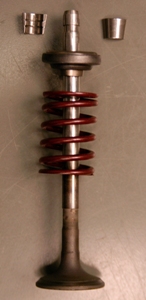
A poppet valve is a valve typically used to control the timing and quantity of gas or vapour flow into an engine.
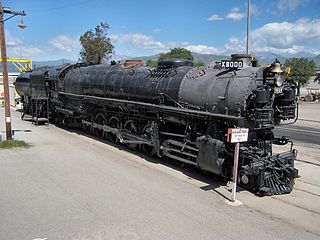
Under the Whyte notation for the classification of steam locomotives, 4-12-2 represents the wheel arrangement of four leading wheels, twelve coupled driving wheels, and two trailing wheels. This arrangement was named the Union Pacific type, after the only railroad to use it.
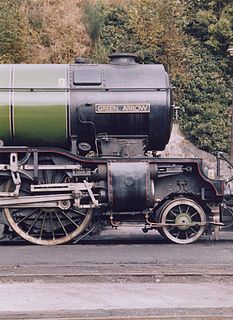
The Gresley conjugated valve gear is a valve gear for steam locomotives designed by Sir Nigel Gresley, chief mechanical engineer of the LNER, assisted by Harold Holcroft. It enables a three-cylinder locomotive to operate with only the two sets of valve gear for the outside cylinders, and derives the valve motion for the inside cylinder from them by means of levers. The gear is sometimes known as the Gresley-Holcroft gear, acknowledging Holcroft's major contributions to its development.

The Stephenson valve gear or Stephenson link or shifting link is a simple design of valve gear that was widely used throughout the world for all kinds of steam engines. It is named after Robert Stephenson but was invented by his employees.

Southern valve gear was briefly popular on steam locomotives in the United States. It combines elements of the Walschaerts and Baker patterns.

The cylinder is the power-producing element of the steam engine powering a steam locomotive. The cylinder is made pressure-tight with end covers and a piston; a valve distributes the steam to the ends of the cylinder. Cylinders were cast in cast iron and later in steel. The cylinder casting includes other features such as valve ports and mounting feet. The last big American locomotives incorporated the cylinders as part of huge one-piece steel castings that were the main frame of the locomotive. Renewable wearing surfaces were needed inside the cylinders and provided by cast-iron bushings.
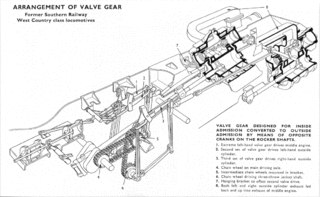
The Bulleid chain-driven valve gear is a type of steam locomotive valve gear designed by Oliver Bulleid during the Second World War for use on his Pacific (4-6-2) designs. It was peculiar to the Southern Railway in Britain, and borrowed from motor-vehicle practice in an attempt to create a compact and efficient design with a minimum of service requirements.

Under the Whyte notation for the classification of steam locomotives by wheel arrangement, 2-6-2+2-6-2 is an articulated locomotive using a pair of 2-6-2 power units back to back, with the boiler and cab suspended between them. The 2-6-2 wheel arrangement has a single pair of leading wheels in a leading truck, followed by three coupled pairs of driving wheels and a pair of trailing wheels in a trailing truck. Since the 2-6-2 type was often called the Prairie type, the corresponding Garratt and Modified Fairlie types were usually known as a Double Prairie.

The Kuhn slide is part of a modified Walschaerts (German:Heusinger) valve gear on steam locomotives and is named after its inventor, Michael Kuhn (1851–1903). The term is also used to refer to this particular type of Walschaerts valve gear system as a whole.
The Rhaetian Railway G 2/3+2/2 was an eight member class of metre gauge Mallet-type steam locomotives manufactured by SLM in Winterthur, Switzerland in 1902, and operated until 1920–1921 by the Rhaetian Railway, in the Canton of Graubünden, Switzerland.

The South African Railways Class 19C 4-8-2 of 1935 was a steam locomotive.
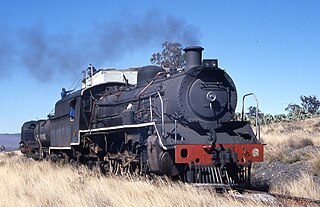
The South African Railways Class 19B 4-8-2 of 1930 was a steam locomotive.
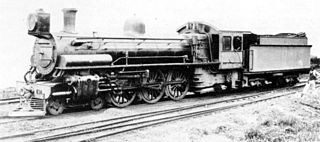
The South African Railways Class 10B 4-6-2 of 1910 was a steam locomotive from the pre-Union era in Transvaal.

The South African Railways Class 10A 4-6-2 of 1910 was a steam locomotive from the pre-Union era in Transvaal.

A return connecting rod, return piston rod or double piston rod engine or back-acting engine is a particular layout for a steam engine.

The W. G. Bagnall New Standard 18 0-6-0ST is a type of industrial steam locomotive manufactured at W. G. Bagnall's Castle Engine Works and designed by Harold Wood at W.G. Bagnall in 1951. The class was specifically designed for the Port Talbot Steelworks, and ran from 1951 to 1973 in industrial service. Two locomotives, the former Longbridge locomotives, are preserved.
GCR Class 9P was a design of four-cylinder steam locomotive of the 4-6-0 wheel arrangement built for hauling express passenger trains on the Great Central Railway in England. A total of six were built: one in 1917, and five in 1920. They were sometimes known as the Lord Faringdon class, from the name of the first one built.
The L&YR 2-10-0 was a prospective design for a class of 2-10-0 steam locomotives on the Lancashire and Yorkshire Railway. Initial designs were made by George Hughes between 1913–1914, but none of the class were built. If they had been, these would have been the UK's first 10-coupled locomotives in regular service.




















